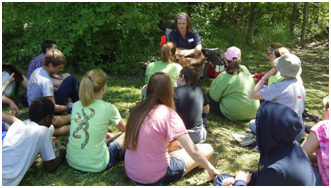Despite some doubting minds (mine included) spring has
finally sprung and that means more to some of us than just the blooming
flowers, singing birds, sunshine and blue skies. To the educators of our area it means the
school kids are finally able to venture out of the classroom on some much
anticipated field trips. Pulaski County
Soil and Water Conservation District was lucky enough to be invited to design multiple
education programs throughout the year.
But nothing beats being able to expose young hearts and minds to the
wonder of our surrounding natural resources.
This spring allowed us to participate in 3 major outdoor learning
programs.
The first was a 4th grade field trip to the
Tippecanoe River State Park. A quick
survey revealed only about 15% of the 125 children had ever visited this gem of
a park a mere 5 miles from their school.
Even on a less than spring like day (40 degrees was our high with a
constant drizzle) the kids’ enthusiasm and excitement at being in a new and
interesting place was infectious.
Each class visited 6 stations consisting of Forestry taught
by District Forester James Pothoff; Erosion and Bank Stabilization taught by
Purdue Extension’s Natalie Daily and Chad Rushing; Park History taught by
Pulaski County SWCD’s Barb Rausch and yours truly; Mussels, Macros and Otters
with Pulaski County SWCD Educator Kathy Wyatt; and finally, the overwhelming
favorite of all the students, Community Service led by ISDA’s Julie Morris and
Deb Jimison. The kids even participated in a word scramble
over their lunch break to solve the clue “Preserve. Guard. Protect.”. After finding all 12 letters hidden around the
park students successfully spelled “Conservation”!
Barb Rausch retells the Potawatomie Tribes story of why the Tippecanoe River is so curvy. (The fur hat on her head is for more than just effect, it was cold!!)

Kathy Wyatt braved the rain to show the kids how important otters, macros and mussels are to indicating the health of local waterways. |
Deb Jimison and Julie Morris were so proud of the hard work done by little hands. Each 4th grade class learned how to identify and remove invasive species from the park. The brush pile pictured is one of many containing autumn olive, garlic mustard and bush honeysuckle. The kids had to be practically dragged away from their workstations to move on to other sessions! But what 9 year old doesn’t love going to work with hand saws and giant pruners?
A few days later, and thankfully about 30 degrees warmer,
found us at the Rausch Family’s National Wetland with 120 2nd
graders. The almost 40 acres of wetland and forest provided the perfect outdoor
experience for these young minds to learn about animal tracking, furs, birds,
forestry, macros, and measurements. Each
class brought with them a large water filled jar that had been the home of the
class tadpoles for a few weeks. The
tadpoles were released into the wetlands and were cheered on by the young
stewards as they ventured into their new homes.
Taking Measurements with Mrs. Wyatt and
Ms. Jimison
 |
| Animal Tracks & Scat with Mr. Rausch, Forestry with
James and Birds of the Wetlands with Julie Morris |
And, of course, what would a field trip be without a fun lunchtime game of “Turtle, Turtle, Otter”? For those who don’t know, that is the twist us SWCD folks put on the traditional “Duck, Duck, Goose”. I mean, who doesn’t love saying, “Turtle, turtle, turtle, turtle, turtle, OTTER!”? (Although, for some reason, I can never get anyone in the office to chase me; no matter how many times I tap the top of their head and say “You’re the otter!!” They really aren’t amused when I run around and try to sit in their seat, especially since they typically never got up to chase me.)
Thankfully the beautiful weather held out for yet another
field day, this one organized by Jasper County Soil and Water Conservation
District’s Jody Wilson and located on the beautiful grounds of the Kankakee
Marsh County Park in Lake County. Jody
teamed up with Rensselaer Schools 8th graders, bringing them out to
learn about this long gone marsh from visiting speakers Rose Morgan (Newton
County SWCD), James Pothoff (DNR), Sarah Wolf (ISDA), and myself! Jody was even
able to recruit Jeff Manes and Jim Sweeney local history experts, as well as,
writer and contributor to the documentary “Everglades of the North”.
I was given the
opportunity to teach these young adults about animals both currently living in
and extinct from the grand marsh. Many
had never even seen some of the animals we had pelts for. The students even played along (with minimal
groaning and eye rolling) in a game to exemplify the importance of using our
natural resources wisely.
 |
None of the students believed beaver pelts were used as currency for early settlers.
Buying groceries with beaver pelts? Crazy! |
Every day we come in to the office with a mission, get
conservation on the ground. So we focus
on our agricultural producers, promoting cover crops, advising on responsible
irrigation, encouraging conservation program sign up, water testing, and the
list goes on. We can’t forget an
important part of that mission is our young people. They may not currently be active stewards of
the land but if we are lucky more than a few of the 400+ students we exposed to
the beauty and value of our natural resources this past week will grow up to
care as much for this land as we do. And
even at their young age they can pass on our message to friends and
family. After all, it is much easier to
get conservation on the ground while you are still as close to ground level as
these small folks are.
Written By: Ashley Brucker,
Pulaski County Soil and Water Conservation District









